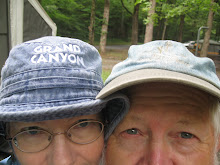Husband Walter and I left our
Georgia tribe Sunday morning, June 1. We would meet up with them again in
Hampton, Virginia, for niece Becky’s and fiance Josh's wedding and festivities.
We had allowed extra
days for a leisurely drive to Hampton and some sightseeing on the way. The next
morning we departed our east Ashville motel for an entrance to the Blue Ridge
Parkway about a mile away.
By mid-afternoon the
realization struck that we were only 60 miles from Ashville, our starting
point. At an average 10 miles per hour, we set a new record low—or make that a
record slow—for our personal travels.
 |
| Our first stop |
But I did enjoy the
chance to take a few photos of spring flowers and mountain scenery that our
slow pace offered. And I especiaaly savored our first stop for the day, the
Folk Art Center. The center features exhibitions, library and craft shop, all
focused on fine crafts handmade in the Southern Appalachians.
On a stop there
several years ago, I was awed by a quilt exhibit. From intricate traditional
patterns to modern fabric “paintings,” I felt I was in the presence of
masterpieces.
On this visit one of
the exhibitions was the work of recent graduates from a regional community
college’s professional crafts department. Wood, metal, fabric, clay and other
materials were the media for furniture, sculpture, pottery, screens, jewelry
and more. The unique creations were beautifully presented.
The urge was strong to
document what I saw with photos. I opted, however, simply to enjoy and to work
on keeping my ever-precarious balance. I definitely did not want to be
remembered as that stroke survivor who crashed the exhibit—literally, and
ruined someone’s labor of love.
Hubby posted photos of
the spacious facility here. I, however, spent my time in the exhibit space
and craft shop. I couldn't resist buying a tiny wooden bride and groom. They were
just two among a variety of “sunfolk,” Christmas ornaments handcrafted from
wood, painted and dressed in tiny fabric apparel.
I love Christmas ornaments. but my official excuse was to have a “happy” for our
real-life prospective bride and groom, Becky and Josh.
 |
| Mountain laurel on the grounds of the Folk Art Center |
 |
| A bee’s eye view of a single laurel blossom. |
We usually see rosebay
(white) rhododendron on our treks to the Smoky Mountains and other areas of the
Appalachians. But on this drive the Catawba (purple) rhododendron was putting
on a show.
The purple-pink blooms looked like the color and structure of the
Formosa azaleas of our region. Our azaleas cover the entire shrub but are single blooms.
In contrast, the rhododendron blooms are a display in pom pom balls of clusters made up of multiple blooms.
 |
| A single Catawba rhododendron bloom |
 |
| Catawba rhododendron blooms offer spheres of botanical color. |
Plus we saw a bear.
That always spices up my day. And even better, he was not eating people food.
He was lounging on the side of the road scarfing down some type of large-leafed green
plant. It was much healthier for him than the scavenged pizza and other people food that I have seen bears eating in previous mountain trips.
 |
| View from parking for trail to Mt. Mitchell summit. |
One of our final stops
before making our way to the interstate was a parking area at the entrance for the trail to the Mt. Mitchell peak and observation tower. We were at 6,578 feet elevation at
the edge of the parking lot. The western mountains of our nation are
spectacular, but I love the spring and summer green of these older mountains.
In 2006, prior to my 2011 stroke, we had hiked to the
top of Mt. Mitchell, at 6684
feet, the highest peak east of the Mississippi.
It was cold in the parking lot, just as it was on our 2006 visit. And I remembered how much colder it had been at the peak. I was content to take a few photos and climb back into our cozy van.
 |
| Three minutes after the first image from the parking lot, clouds move in over distant peaks. |
Hubby’s post on the day’s jaunt is
here.


































